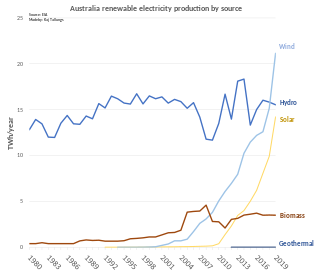
The ExPlace Wind Turbine is a 91-metre (299 ft) tall wind turbine located on the grounds of the Exhibition Place co-owned by the WindShare for-profit co-operative and Toronto Hydro. It is the first wind turbine installed in a major North American urban city centre, and the first community-owned wind power project in Ontario. WindShare itself was officially launched in February 2002 in Toronto, Ontario, Canada. It was created by the non-profit Toronto Renewable Energy Co-operative (TREC) which was incorporated in 1998. TREC continues to exist as a separate non-profit entity.

The electricity sector in Canada has played a significant role in the economic and political life of the country since the late 19th century. The sector is organized along provincial and territorial lines. In a majority of provinces, large government-owned integrated public utilities play a leading role in the generation, transmission, and distribution of electricity. Ontario and Alberta have created electricity markets in the last decade to increase investment and competition in this sector of the economy.

Renewable energy in Australia includes wind power, hydroelectricity, solar photovoltaics, heat pumps, geothermal, wave and solar thermal energy.
Wind power has a history in Canada dating back many decades, particularly on prairie farms. As of December 2021, wind power generating capacity was approximately 14,304 megawatts (MW). Combined with 2,399 MW of solar power generating capacity, this provided about 6.5% of Canada's electricity demand as of 2020. The Canadian Wind Energy Association (CanWEA) has outlined a future strategy for wind energy that would reach a capacity of 55 GW by 2025, meeting 20% of the country's energy needs.
For solar power, South Asia has the ideal combination of both high solar insolation and a high density of potential customers.
Financial incentives for photovoltaics are incentives offered to electricity consumers to install and operate solar-electric generating systems, also known as photovoltaics (PV).

The World Wind Energy Association (WWEA) is an international non-profit association representing the wind power sector worldwide, with members in 100 countries, amongst them the leading national and regional wind energy associations. The organisation works for the promotion and worldwide deployment of wind energy technology and advocates a future energy system based on renewable energy.

Renewable energy in the United Kingdom contributes to production for electricity, heat, and transport.
A feed-in tariff is a policy mechanism designed to accelerate investment in renewable energy technologies by offering long-term contracts to renewable energy producers. This means promising renewable energy producers an above-market price and providing price certainty and long-term contracts that help finance renewable energy investments. Typically, FITs award different prices to different sources of renewable energy in order to encourage development of one technology over another. For example, technologies such as wind power and solar PV are awarded a higher price per kWh than tidal power. FITs often include a "degression": a gradual decrease of the price or tariff in order to follow and encourage technological cost reductions.

Renewable energy in developing countries is an increasingly used alternative to fossil fuel energy, as these countries scale up their energy supplies and address energy poverty. Renewable energy technology was once seen as unaffordable for developing countries. However, since 2015, investment in non-hydro renewable energy has been higher in developing countries than in developed countries, and comprised 54% of global renewable energy investment in 2019. The International Energy Agency forecasts that renewable energy will provide the majority of energy supply growth through 2030 in Africa and Central and South America, and 42% of supply growth in China.

Community wind projects are locally owned by farmers, investors, businesses, schools, utilities, or other public or private entities who utilize wind energy to support and reduce energy costs to the local community. The key feature is that local community members have a significant, direct financial stake in the project beyond land lease payments and tax revenue. Projects may be used for on-site power or to generate wholesale power for sale, usually on a commercial-scale greater than 100 kW.
The Green Energy Act (GEA), formally the Green Energy and Green Economy Act, 2009, introduced in the Ontario legislature on February 23, 2009 and later repealed on January 1, 2019, was intended to expand renewable energy production, encourage energy conservation and create green jobs. Among many clauses, the GEA was best known for creating a number of feed-in tariff rates for different types of energy sources. Notable among these is the microFIT program for small non-commercial systems under 10 kilowatts, and FIT, the larger commercial version which covers a number of project types with sizes into the megawatts.

As of 2019, renewable energy technologies provide about 17.3% of Canada's total primary energy supply. For electricity renewables provide 67%, with 15% from nuclear and 18% from hydrocarbons.

The electricity sector in Sri Lanka has a national grid which is primarily powered by hydroelectric power and thermal power, with sources such as photovoltaics and wind power in early stages of deployment. Although potential sites are being identified, other power sources such as geothermal, nuclear, solar thermal and wave power are not used in the power generation process for the national grid.

Policy makers often debate the constraints and opportunities of renewable energy.

The State Agency on Alternative and Renewable Energy Sources, SAARES is a governmental agency under the Ministry of Industry and Energy mandated by the Cabinet of Ministers. It serves as the principal regulatory institution in the sphere of alternative and renewable energy in the Republic of Azerbaijan. The State Agency is headed by Akim Badalov.
Electricity in Cyprus is managed by the Electricity Authority of Cyprus. Power is primarily generated at three fuel oil-burning stations but the use of distributed renewable energy is expanding.

Renewable energy in Taiwan contributed to 8.7% of national electricity generation as of end of 2013. The total installed capacity of renewable energy in Taiwan by the end of 2013 was 3.76 GW. As of 2020, the Taiwan government aims for a renewable share of 20% by 2025, with coal and gas providing the other 80%.

Renewables supply a quarter of energy in Turkey, including heat and electricity. Some houses have rooftop solar water heating, and hot water from underground warms many spas and greenhouses. In parts of the west hot rocks are shallow enough to generate electricity as well as heat. Wind turbines, also mainly near western cities and industry, generate a tenth of Turkey’s electricity. Hydropower, mostly from dams in the east, is the only modern renewable energy which is fully exploited. Hydropower averages about a fifth of the country's electricity, but much less in drought years. Apart from wind and hydro, other renewables; such as geothermal, solar and biogas; together generated almost a tenth of Turkey’s electricity in 2022.













